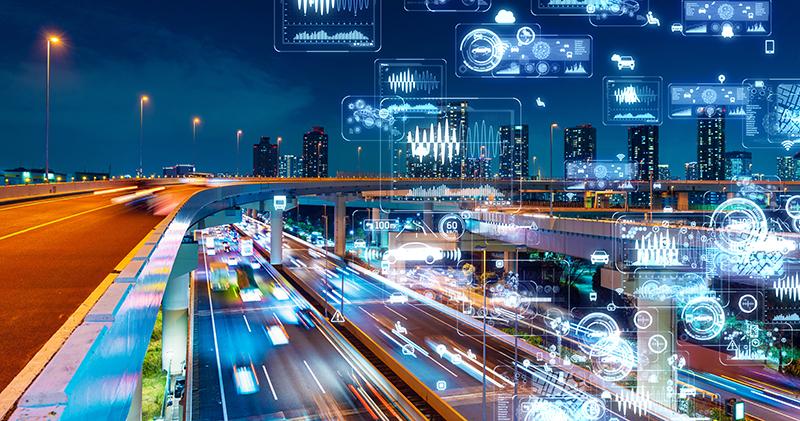Autonomy in the city – the road to smart transportation
As autonomous and connected vehicles emerge from concept towards reality, the feasibility of creating smart cities was up for discussion at a recent event.

‘This is a technology with a lot of hype, and it seems [it has been] happening for a long time. It's had some unrealistic expectations of when it would see fruition, simply from some of the big American companies…But I think real progress is being made now,’ reflected David Hamson, Deputy Head at the Centre for Connected & Autonomous Vehicles for the Department of Transport (DfT), UK. He was speaking at a recent online policy conference on ‘Connected and autonomous transport’, where delegates shared their thoughts on integrating smart technologies into cities.
‘There is a huge opportunity around connected and autonomous vehicles and the new services they enable,’ shared Paul Gadd, Deputy Director for Land Transport, Manufacturing and Materials at Innovate UK. ‘From a safety point of view, human error is thought to be a factor in 95% of all road accidents. And each year, unfortunately, more than 1,700 people are killed on UK roads with a further 153,000 casualties. Globally, the number is 1.35 million people killed every year.’
Hamson added, ‘There's potential there because computers never get tired, never switch off, [which could] improve safety and increase productivity.’
According to the DfT, it is estimated that one in every five miles travelled by consumers in the UK could be autonomous by 2030. The department forecasts that the knock-on effect could save the lives of more than the 3,900 people and prevent over 47,000 serious accidents.
‘That is a critical societal challenge,’ Gadd remarked. ‘But one that also brings along an economic impact as well.’ The World Health Organisation estimates that road traffic crashes cost most countries 3% of their GDP.
Driving in
‘The global market for connected and autonomous vehicles is expected to be over £900bln in 2035, with the UK market estimated at £28bln,’ Gadd continued. ‘And, as an emerging market, the supply chains and the key suppliers are not yet established. So, some big opportunities [are] to be unlocked. And we have some great UK companies diving into this space and [already] deploying vehicles.’
However, Andrew Pearce, Atkins’ Practice Director of Intelligent & Smart Technology in UK & Europe, explained that ‘we have…to move beyond the bullet points to the business case – the Jerry Maguire moment ‘show me the money’’.
Pearce suggested that, considering factors such as signs, signals and traffic controls, the UK could witness a 'cash' benefit of up to £320mln per year. This figure could also rise sevenfold when accounting for other cashable and economic benefits, including the largest category of notional benefits, those of GDP/time and safety.
Gadd outlined some of the other advantages. ‘Increased connectivity enables collaborative driving and traffic management. And that can reduce congestion. Increasing levels of autonomy should make driving smoother, bringing a reduction in emissions or energy consumption for electric vehicles. This also reduces tyre and brake wear, which is a significant source of particulates.’
Autonomy in transport also breeds inclusivity, Hamson argued. ‘For people who can't drive for reasons of age, disability, it opens up new avenues to get around.’
A digital infrastructure could provide ‘more flexibility [and] more choice – particularly for people who live in potentially less economically well-off areas or rural areas. It should increase the economic viability of spreading those services further with the same money. So, it's an increased access to transport across the board rather than just accessibility, but accessibility is a really important part…of transport.’
It was a perspective echoed by Gadd. ‘This greater accessibility and inclusivity are aligned with the government's agenda of levelling up…Autonomy releases the driver’s time and combined with increasing levels of connectivity means that time can be far more productive.’
Tracking 3D motions
A real-time, 3D motion tracking system to replace light detection and ranging (LiDAR) technology and cameras in autonomous technologies is being proposed at the University of Michigan, USA.
Combined with advanced neural network methods, the system exploits the advantages of transparent, nanoscale and highly sensitive graphene photodetectors. The team claims this could be used for automated manufacturing, biomedical imaging and autonomous driving in the future.
‘The in-depth combination of graphene nanodevices and machine learning algorithms can lead to fascinating opportunities in both science and technology,’ says Dehui Zhang, a Doctoral Student in electrical and computer engineering at the University.
‘Our system combines computational power efficiency, fast tracking speed, compact hardware and a lower cost compared with several other solutions.’
Risky business
‘There are some risks as well,’ he continued. ‘To maximise the delivery of societal benefits requires collaboration from economic actors, and local and national legislators and regulators. That requires time and effort. And there's a risk these organisations are not resourced to understand this technology and its impacts, and [that] vehicles arrive on UK roads ahead of new regulation.’
One of the key challenges explored at the event was cyber security. ‘There's around one trillion devices worldwide – they will be connected over a complex of networks and different types of systems by 2025. And end-to-end security of the communication is not guaranteed with today's cyber security solutions,’ warned Shadi Razak, Chief Technology Officer of UK cyber security start-up, Angoka.
‘A lot of the typical methods that we have on cyber security and risk assessments are not fit for such an ecosystem because it hasn't been designed for such an ecosystem.
‘If we look on the camera or the mode of connected autonomous vehicles, it is a group of Internet of Things devices, or a physical and a digital system that is running on the roads as we know. Now, that problem is not just our own vehicle itself, [but also] that mix between the physical world and the digital world, and the connectivity between them…The system was designed for reliability and not connectivity, and now they are being open and being connected.’
Gadd proposed that another big risk is in sovereign capability, which could shut down the whole transport system. ‘If transport efficiency, or even transport functionality, is dependent on connectivity, we need to consider who the connectivity is provided by. That includes the whole system, not just the vehicle-to-vehicle or vehicle-to-infrastructure connection software, and the hardware is the supporting infrastructure and the servers through which the messages and data are sent and stored. Losing data is certainly damaging in cyber-attacks today. But losing control of vehicles in motion brings a whole new level of concern.’
Razak believes there needs to be a new way of machine-to-machine communication. ‘And by moving the Root of Trust [the foundational security component of a connected device], out of the networks and the third parties and putting it into the device itself, [it] allows the devices to have that authority – we do that by embedding our device authentication into each device. [This] allows them to generate a unique and affordable DNA for each device, and each vehicle.’
Michael Hurwitz, Director of Transport Innovation at Transport for London (TfL), highlighted the seismic shift at play. ‘There is huge potential from a technical feasibility perspective. But the transition is going to be very long and, for us in TfL, we have to operate the roads on a day-to-day basis. When we make upgrades to how we run the network or the bus or the tube system, we have to make additions to that in real time while the systems are in flight.
‘There is a fundamental question now, which I believe lies with the central approval authorities, which is that we will not get to the mass expansion unless we grasp and resolve the question of how safe is safe enough. And that goes from the data point of view. And it also goes from the vehicle safety, on street point of view as well.
‘This is really hard. It requires a huge coming together of governance that does not exist. And fundamentally, it requires a transformation in the capabilities that are traditionally in those approval authorities. Until very recently, approval authorities had relative expertise in mechanical engineering and electrical engineering. And now of course, that has to shift to software engineering. [It will be] even harder when you have artificial intelligence machine learning systems that constantly evolve in use.’
Part of the journey
Ultimately, as always, continued investment is fundamental to the technology's implementation. ‘This isn't the time to stop investing,’ insisted Gadd. ‘Further investment over the coming years will increase UK content in future supply chains. That, in turn, delivers jobs, wealth and exports. Investment would further ensure products and services are focused on UK challenges and deliver maximum societal value. And finally, by increasing UK content and understanding, we significantly increase the security of a quickly evolving critical national infrastructure in transport.
‘Crucially…[it will take] government, industry, academia, local authorities and civil society working together to deliver those benefits,’ he urged.







